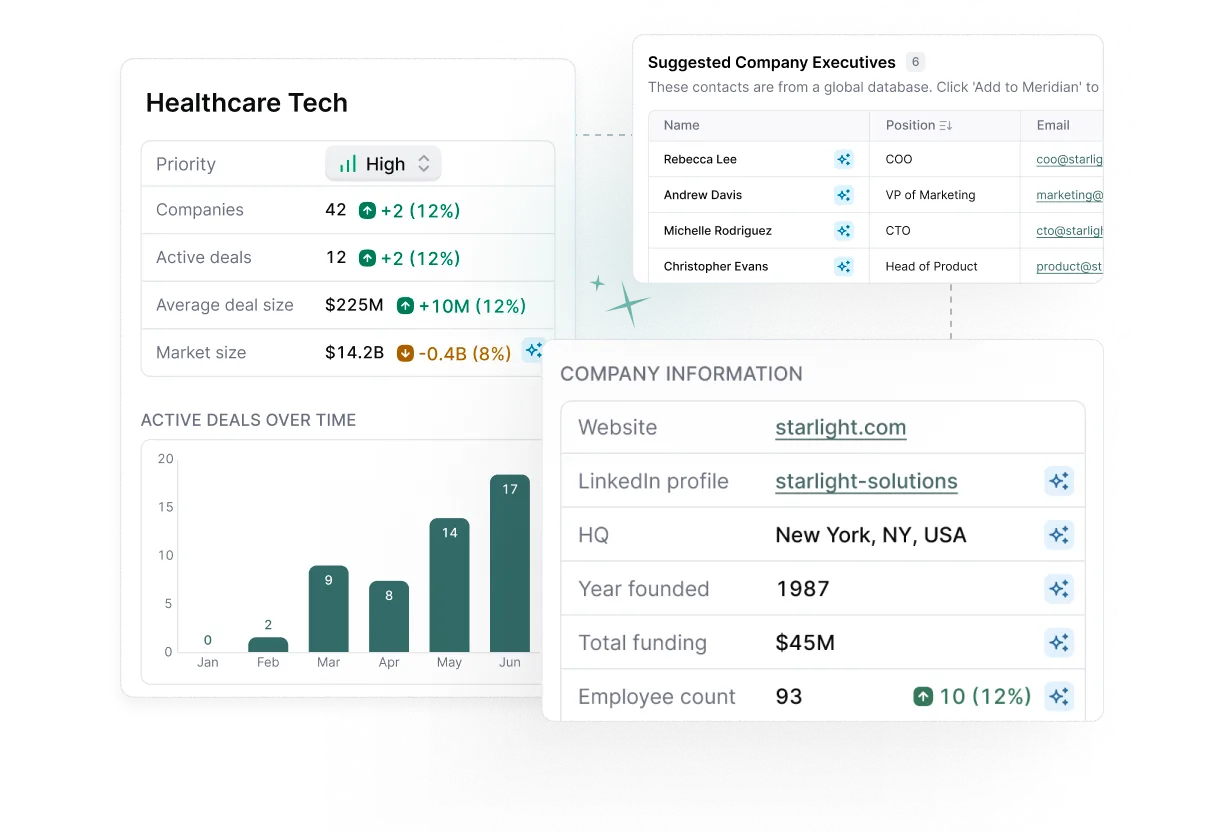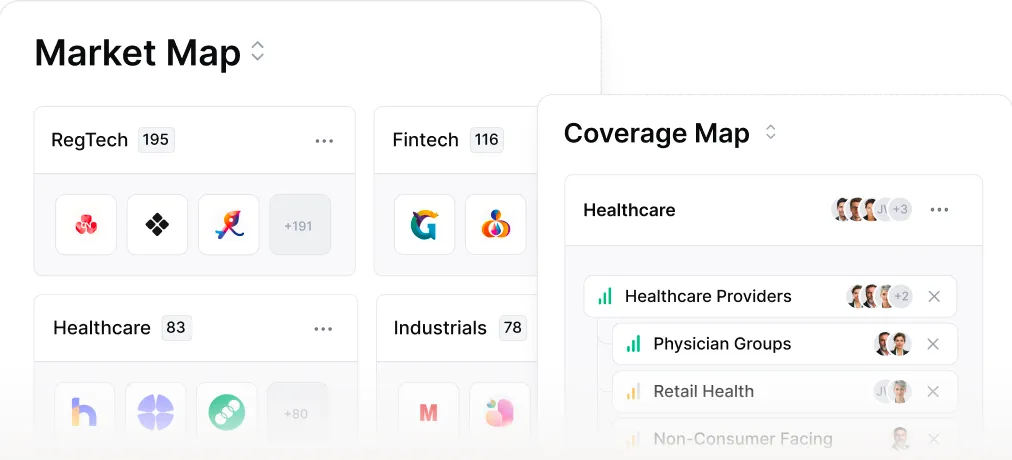Meridian raises $7M seed round led by 645 Ventures.
Read More
Design a durable theme-tracking system to refresh, validate, and operationalize theses over multi-year horizons.

Private equity is more competitive than ever before, with an increasing number of firms hunting for the same targets. To score the deals that bring the best returns, your team needs to be tracking opportunities far before they go to auction.
But for this to work, you have to move away from deal-by-deal thesis development towards a programmatic, long-term approach that lets you map sub-themes, track relevant signals, and convert research into pipeline.
Winning firms are able to translate long-arc themes into repeatable sourcing and faster IC. In this article, we show you how to design a scalable framework for tracking investment themes, as well as how Meridian helps firms turn that system into a long-term advantage.
Unstructured work leads to deal teams building an investment thesis around disorganized industry decks. But unstructured sector-based investment research is impractical, hard to scale, and easily replicated by other firms. What’s more, it doesn’t actually surface the most promising opportunities
Going after hot targets, like manufacturing businesses that are optimizing their supply chains through digitization, might seem like a good move. But unless you track themes over multi-year cycles, you can’t know if they just look promising now or are actually on an upward trend.
But when you start tracking investment themes strategically, you’re able to identify key structural shifts (e.g., in market trends, supply chains, consumer behavior, or technology), then systematically build a pipeline around business models aligned with that theme.
Take, for example, the global electrification of transport. With systematic thematic investing, you wouldn’t focus solely on car manufacturers like Tesla or BYD. Instead, you’d map the entire electric vehicle (EV) ecosystem, identifying growth enablers and inhibitors across the value chain. This opens up opportunities across the supply chain and related industries, from entities that mine and process lithium, nickel, and other materials used to manufacture EV batteries, to firms that develop vehicle energy infrastructure.
In other words, tracking the space gives you insights into exactly where the value lies. You’ve built conviction on what drives growth, where supply chains are shifting, and how consumer behavior is changing, all of which help you spot promising trends and capitalize on them faster.
Key takeaway: Thematic investing enables private equity firms to identify strong opportunities before competitors. And continuous coverage means you don’t just identify a theme once and move on; you keep tabs on the data, players, and signals that shape it.
The payoff comes fast when you start building themes systematically. You move from a reactive investment strategy to one that’s proactive and evidence-led, helping you to identify the right assets early and build conviction faster.
Key takeaway: While any type of investing involves risk, thematic investing can help you get ahead of evolving trends in the market before competing firms even have them on their radar.
Once you start mapping markets and tracking signals, you’re suddenly dealing with thousands of data points from fragmented sources. Turning that noise into valuable insights that can actually drive investment decisions is where most firms stumble.
Manual research slows investment processes, and static spreadsheets can’t keep up with fast-moving market signals. Without structure and automation, even the best ideas fade before they compound into returns.
However, a CRM designed for private equity can help you draw value from the information you collect and turn your insights into opportunities. Meridian, for example, leverages AI to help you sift through massive volumes of data, extract relevant patterns, and organize them around actionable themes.
By connecting these insights directly to deal and company records, with verified data on 26+ million companies, Meridian lets sourcing teams see which sectors are gaining traction (and which aren’t) without losing momentum.
We’ve broken theme tracking down into a clear roadmap that can help deal teams identify investment opportunities, streamline the sourcing process, and build a scalable system that keeps delivering value over time.
Before anything else, you need to define what qualifies as a theme worth tracking. Durable PE themes are standardized, queryable records that live inside your CRM, not scattered across disparate IC memos or spreadsheets.
Each theme should be tagged, categorized, and linked to deals and opportunities so that anyone on the team can find them quickly, even years later.
The best themes are broad enough to evolve with the market environment, yet specific enough to guide sourcing: think climate transition, artificial intelligence, or biotech.
Once you’ve built this structure, you can start tracking key trends at scale. Your themes become living, searchable frameworks that outlast personnel changes, preserve institutional knowledge, and keep your deal team focused on where opportunity is moving next.
With your themes defined, the next step is to choose signals that will be meaningful over years, not weeks.
Tracking short-term noise in financial markets might make for interesting chatter, but it rarely translates into long-term insight. What you want instead is structured, compounding market intelligence that helps you see how a theme is evolving over time.
A good starting point is to identify seven to ten durable signals per theme, from hiring velocity to customer sentiment.
The goal isn’t to predict the future; it’s to build a body of evidence that shows how themes evolve across cycles. While past performance can never guarantee future results, disciplined signal tracking gives you a clearer view of what’s shifting and why it matters for your next move.
Thematic investing works best when signals are turned into a single, clear metric like a theme health score.
Start by normalizing each tracked signal on a scale of 0 to 100, then aggregate into a composite score. Use this method to quantify how strong or weak a theme is at any point in time.
For instance, suppose you’re tracking the climate transition theme. You might include signals such as renewable project approvals, hiring activity at companies in clean tech, and shifts in carbon credit pricing. If the average score dips below 45, you pause active sourcing; between 45 and 75, you maintain coverage; above 75, you prioritize it in your pipeline.
This brings consistency to your thematic investing strategy. It also helps teams compare themes across asset classes and geographies, focusing attention where conviction is highest.
Once you’ve built your main themes, it’s time to translate ideas into objective inclusion criteria. This means mapping out the sub-themes that make each one actionable.
For every major theme, define two to four sub-themes with a short “why now” statement that explains its relevance in the global economy. The “why now” acts as a timing signal, capturing what makes a sub-theme attractive today rather than someday.
Take artificial intelligence as an example. A PE team might break it into sub-themes like “AI-enabled manufacturing”, “AI data centers”, “AI governance tools”, and “AI in healthcare”.
The “why now” could include factors like enterprise AI budgets expanding, chip supply easing, or legislation evolving along with AI advancements. Each has its own momentum, shaped by adoption curves across specific industries.
From there, you’ll want to create profiles that capture what a winning target looks like. Doing this is the first step towards building meaningful relationships with the companies that best align with your thematic focus.
Analyzing your investment decisions on an ad hoc basis is a surefire way for your thematic program to stall. Setting a clear cadence keeps teams aligned without creating unnecessary noise. Aim for a realistic cadence: a quarterly analysis to refresh data and signals, and a semi-annual review to decide whether each theme still merits attention.
Decisions should be documented directly in your CRM, linking updated insights, company interactions, and pipeline changes to each theme. That makes it easier to tie your view of investment opportunities to shifts in regulation, technology, or consumer behavior.
A consistent review cycle preserves focus on the themes with real long-term potential and helps you avoid reactionary pivots.
Close your review cycle by creating a concise, two-page memo capturing what changed, what you learned, and how it impacts your thesis. Include a clear decision about whether you’re doubling down on, maintaining, pausing, or retiring the theme.
It’s also a good idea to include an updated market map and a theme health score trend. This turns your investment strategy into a living ecosystem where you can track progress over time and clarify the risk factors driving every decision.
Done right, refresh memos make your thinking auditable and your decisions portable, serving a living record that links insight to action and keeps your firm’s thematic engine running.
Building a scalable system for thematic sourcing takes more than big ideas; it takes scalable infrastructure. Meridian gives PE firms that foundation, helping you track, refresh, and validate investment themes over years instead of quarters.
Our market mapping tools visualize how opportunities evolve, while Scout AI surfaces emerging patterns and links them to real-world signals. Plus, automated data capture and enrichment keep information flow alive and dynamic to create a single source of truth that ties every insight to deals, companies, and relationships.
The result is a durable operating layer for thematic investing that compounds knowledge, shortens reaction time, and keeps your firm in front of the best opportunities.
Market mapping, automatic data enrichment, and one-click activity sync help you centralize information and identify opportunities long before they come to option.

Discover how Meridian can streamline deal sourcing and enhance your decision-making

Table of Contents


Market intelligence gives PE firms a competitive edge for sourcing and closing the best deals. Learn about the workflows and tools top firms turn to.

